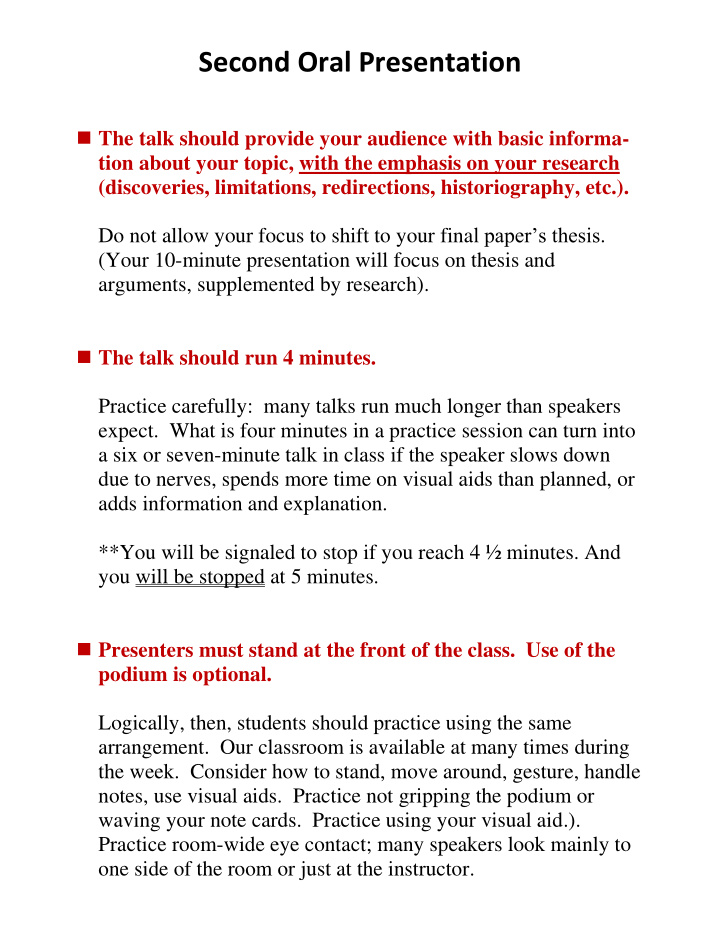



Second Oral Presentation The talk should provide your audience with basic informa- tion about your topic, with the emphasis on your research (discoveries, limitations, redirections, historiography, etc.). Do not allow your focus to shift to your fina l paper’s thesis . (Your 10-minute presentation will focus on thesis and arguments, supplemented by research). The talk should run 4 minutes. Practice carefully: many talks run much longer than speakers expect. What is four minutes in a practice session can turn into a six or seven-minute talk in class if the speaker slows down due to nerves, spends more time on visual aids than planned, or adds information and explanation. **You will be signaled to stop if you reach 4 ½ minutes. And you will be stopped at 5 minutes. Presenters must stand at the front of the class. Use of the podium is optional. Logically, then, students should practice using the same arrangement. Our classroom is available at many times during the week. Consider how to stand, move around, gesture, handle notes, use visual aids. Practice not gripping the podium or waving your note cards. Practice using your visual aid.). Practice room-wide eye contact; many speakers look mainly to one side of the room or just at the instructor.
Your topic and your talk’s thesis and organization should be clearly set out in the introduction. Make it clear to your audience what you will be doing in your 4-minute talk. What is its purpose? What is its argument? What is its organization? In all parts of your presentation, remember the usefulness of “signposts” and repetition. Remember the value of an appealing and informative introductory statement (i.e., something more than “ ah, my topic is” or “so, today I’m going to talk about” ). A brief reference to an intriguing fact about your topic, your interest in it, or the sources (secondary or primary), for example, can ease both you and your audience into your talk. Be sure that your conclusion pulls together your talk (perhaps by returning to the intriguing fact in your introduction). Your conclusion should make it clear that you are wrapping up. Simply stopping or saying “that’s it” or “questions ? ” out of the blue is not acceptable. You must plan what you are going to say; do not count on a useful conclusion to pop into your head at minute four . End, allow your classmates to applaud, and then ask for questions.
Notes must be key words and phrases with lots of white space to separate items and make them easy to read during your talk. They must be sufficient to get you through any situation if you get lost or distracted, BUT they must not be so detailed that they provide unnecessary detail that make their use difficult. Failure to use notes that are key words and phrases: up to 10 points. Failure to turn in notes immediately after talk: 10 points. Reading a script or delivering a memorized talk: up to 30 points. Your grade will be affected by not only the usefulness and appropriateness of your notes but also how you handle them during your talk. Do you want note cards? Half-sheets of paper? Full sheets? Where do you want them during your talk? (They need to be accessible but not distracting to your audience — through waving, flipping/shuffling, limiting your natural gestures, etc.) Dress appropriately. Convey to your audience that you are taking your presentation seriously: you have something important to say, and your audience should respect both you and your arguments/evidence. Inappropriate attire — such as gym clothes, wrinkled or dirty t- shirts and jeans, shorts, flip-flops — will result in a penalty.
Use power point. It gives you a reason to move around and to take your attention from the eyes watching you. It gives your audience a supplement to your spoken words — and it moves their eyes away from you. TIP: Plan your talk, particularly your thesis and supporting points. Then , think about possible visual aids (pictures, maps, lists, charts) that help clarify either or both. Fancy is not necessary or even desirable. Clear and useful are. If you need help or suggestion, the SPEAKING CENTER can instruct and advise. Words should be minimal: the audience has your spoken words, so what it needs is visual support. Pay attention to font, color, length, consistency. REMINDER: Prepare a presentation that uses power point, not a power-point presentation. Talks will be taped, and each student must meet with the Speaking Center to review the talk BEFORE he/she can meet with the instructor. You have a week to go to the Speaking Center and then meet with the instructor. It is a good idea to schedule an appointment ahead of time, i.e., NOW. (If you wait to schedule your meeting
and there are no times available, that is YOUR fault and you will be penalized.) A meeting that results from talking a consultant into creating an appointment outside of planned hours will not be accepted as meeting the course requirement. Failure to review tape at Speaking Center: 20 points. Failure to meet with the instructor to review talk: 20 points.
Recommend
More recommend